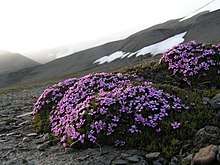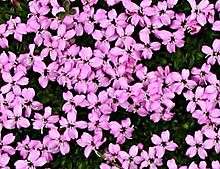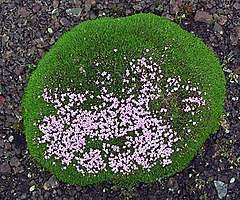Silene acaulis
Silene acaulis, known as moss campion[1] or cushion pink, is a small mountain-dwelling wildflower that is common all over the high arctic and tundra in the higher mountains of Eurasia and North America, (south to the Alps, Carpathians, southern Siberia, Pyrenees, British Isles, Iceland, Faroe Islands, Rocky Mountains). It is an evergreen perennial flowering plant in the carnation family Caryophyllaceae.
| Silene acaulis | |
|---|---|
 | |
| Silene acaulis in Svalbard | |
| Scientific classification | |
| Kingdom: | Plantae |
| Clade: | Tracheophytes |
| Clade: | Angiosperms |
| Clade: | Eudicots |
| Order: | Caryophyllales |
| Family: | Caryophyllaceae |
| Genus: | Silene |
| Species: | S. acaulis |
| Binomial name | |
| Silene acaulis | |
It is also called the compass plant, since the flowers appear first on the south side of the cushion.[2] (Various other plants also have this name.)
Description

Moss campion is a low, ground-hugging plant. It may seem densely matted and moss-like.[3] The dense cushions are up to a foot or more in diameter. The plants are usually about 2" tall but may be as high as 6". The bright green leaves are narrow, arising from the base of the plant. The dead leaves from the previous season persist for years, and pink flowers are borne singly on short stalks that may be up to 1" long, but are usually much shorter. It usually has pink flowers, though very rarely they may be white.[3] The flowers are solitary and star-shaped. They are between 6 and 12 mm wide, with hermaphrodite flowers being larger than the female ones.[4] Female flowers produce better quality seeds than hermaphrodites[5] and male flowers produce better quality pollen than hermaphrodites.[6] The cushions can change the gender of their flowers between years.[7] Gender frequencies change with altitude, the frequency of female flowers increasing with higher elevation.[4] They usually appear in June through August.[8] The flowers are held by a calyx which is rather firm and thick.[9] The flowers are female, male or hermaphrodites.[10]
The sepals are joined together into a tube that conceals the bases of the petals, which are entire. The 10 stamens and 3 styles extend well beyond the throat of the flower.[11] This genus, circumpolar in its distribution, is closely related to carnations.[8] The stems and leaves are very sticky and viscid, which may discourage ants and beetles from climbing on the plant.[9] The variety exscapa has shorter flowering stems. The other variety subacaulescens, from Wyoming and Colorado, has pale pink flowers all summer.[8]
Habitat
Alpine fellfield, on windswept rocky ridges and summits above treeline. It grows mainly in dry, gravelly localities, but also in damper places. With the cushions it produces its own, warmer climate with higher temperatures inside, when the sun shines.[12]
Distribution and range

Common all over the high arctic and the higher mountains of Eurasia and North America, (south to the Alps, Carpathians, southern Siberia, Pyrenees, British Isles, Iceland, Faroe Islands, Rocky Mountains, ). In the United States it inhabits Colorado, the Big Horn Mountains of Wyoming, the Wallowa Mountains of Oregon, the Olympics, the northern Cascades of Washington and Alaska.[8]
Range:
- USA (AK, AZ, CO, ID, ME, MT, NH, NM, NV, OR, UT, WA, WY)
- CAN (AB, BC, LB, NF, NS, NT, NU, ON, QC, SK, YT)
- DEN (GL), FRA (SPM)
Propagation
The seeds should be sown early in the spring time. Put the seedlings into separate pots, and it is recommended to let them winter in the greenhouse for their first winter season. To clean them rub the capsules through a screen. It's advised to plant them in the late spring or early summer because division takes place in the spring. They should be grown in well-drained soil with full sun. The climate can be cool.[13]
Endangerment information
In Maine it is possibly extirpated,[14] and in New Hampshire Silene acaulis var. exscapa is threatened.[14]
History
Plants in Colorado have been estimated to reach 75 to 100 years in age, and Alaskan plants may reach 300 years. The oldest known Moss campion is 350 years old and has a diameter of two feet.[12] The plant used to be used for children with colic.[13] The raw root skin plants were consumed as a vegetable in Iceland and in Arctic regions.[13]
Climate warming impact
Experimental warming has been shown to start flowering substantially earlier than control cushions experiencing ambient temperature. Both the male and female phases developed faster in the OTCs and capsules (fruits) matured earlier, and the cushions produced more mature seeds and had a higher seed/ovule ratio contributing to an overall positive reproductive response.[15] However, a study on four populations across a latitudinal gradient in North America showed that southern populations of moss campion had lower survival and recruitment, but higher individual growth rates than more northern populations. Furthermore, vital rates such as growth, survival, and fruits per area were shown to increase in moderately warmer years yet declined in the very warmest years, suggesting that a change in climate into warmer conditions or more frequent unusually warm summers may eventually lead to negative impacts.[16] Another study showed that while the short term responses were positive, they turned negative on medium-term, suggestion that moss campion may be at risk in future global warming.[17] Projections produced under different climate scenarios suggest that S. acaulis will likely face climate-driven fast decline in suitable areas on the British Isles and across North America, and that upward and northward shifts to occupy new climatically suitable areas are improbable in the future.[18][19]
Hazards/toxicity
There is no listing that moss campion is toxic, though it does have saponins which, though toxic, are hard to absorb in the body. They can be broken down by thorough cooking. Its advised to not consume large amounts of this plant.
Gallery
See also
References
- "BSBI List 2007". Botanical Society of Britain and Ireland. Archived from the original (xls) on 2015-01-25. Retrieved 2014-10-17.
- "The terrestrial vegetation in Svalbard".
- Weber, William A. (1987). Colorado Flora. Western Slope. Boulder, CO: Colorado Associated University Press. ISBN 9780870811678.
- Alatalo, Juha M.; Molau, Ulf (July 1995). "Effect of altitude on the sex ratio in populations of Silene acaulis (Caryophyllaceae)". Nordic Journal of Botany. 15 (3): 251–256. doi:10.1111/j.1756-1051.1995.tb00150.x.
- Shykoff, Jacqui A. (1988). "Maintenance of gynodioecy in Silene acaulis (Caryophyllaceae): Stage specific fecundity and viability selection". American Journal of Botany. 75 (6): 844–850. doi:10.2307/2444003. JSTOR 2444003.
- Alatalo, Juha M.; Molau, Ulf (August 2001). "Pollen viability and limitation of seed production in a population of the circumpolar cushion plant, Silene acaulis (Caryophyllaceae)". Nordic Journal of Botany. 21 (4): 365–372. doi:10.1111/j.1756-1051.2001.tb00780.x.
- Alatalo, Juha M. (June 1997). "Gender lability in trioecious Silene acaulis (Caryophyllaceae)". Nordic Journal of Botany. 17 (2): 181–183. doi:10.1111/j.1756-1051.1997.tb00307.x.
- Nicholls, Graham, and Rick Lupp. Alpine Plants of North America: an Encyclopedia of Mountain Flowers from the Rockies to Alaska. Portland: Timber, 2002.
- Zwinger, Ann, and Beatrice E. Willard. Land above the Trees: a Guide to American Alpine Tundra. Boulder, CO: Johnson, 1996.
- Morris W, Doak D (June 1998). "Life history of the long-lived gynodioecious cushion plant Silene acaulis (Caryophyllaceae), inferred from size-based population projection matrices". American Journal of Botany. 85 (6): 784–793. doi:10.2307/2446413. JSTOR 2446413. Archived from the original on 2016-12-17.
- Phillips, W (1999). Central Rocky Mountain Wildflowers: A Field Guide to Common Wildflowers, Shrubs, and Trees. Falcon Publishing, Inc.
- Benedict, Audrey D. The Naturalist's Guide to the Southern Rockies: Colorado, Southern Wyoming, and Northern New Mexico. Golden, CO: Fulcrum Pub., 2008.
- "Silene acaulis Moss Campion PFAF Plant Database".
- "Silene acaulis (L.) Jacq. – moss campion". PLANTS Profile. USDA. Archived from the original on 2006-05-11.
- Alatalo, J.M.; Totland, Ø. (December 1997). "Response to simulated climatic change in an alpine and subarctic pollen‐risk strategist, Silene acaulis". Global Change Biology. 3 (S1): 74–79. Bibcode:1997GCBio...3S..74A. doi:10.1111/j.1365-2486.1997.gcb133.x.
- Doak, Daniel F.; Morris, William F. (October 2010). "Demographic compensation and tipping points in climate-induced range shifts". Nature. 467 (7318): 959–962. Bibcode:2010Natur.467..959D. doi:10.1038/nature09439. PMID 20962844.
- Alatalo, Juha M.; Little, Chelsea J. (March 2014). "Simulated global change: contrasting short and medium term growth and reproductive responses of a common alpine/Arctic cushion plant to experimental warming and nutrient enhancement". SpringerPlus. 3 (1): 157. doi:10.1186/2193-1801-3-157. PMC 4000594. PMID 24790813.
- Ferrarini, Alessandro; Alsafran, Mohammed H. S. A.; Dai, Junhu; Alatalo, Juha M. (2019). "Improving niche projections of plant species under climate change: Silene acaulis on the British Isles as a case study". Climate Dynamics. 52 (3–4): 1413–1423. Bibcode:2019ClDy...52.1413F. doi:10.1007/s00382-018-4200-9. ISSN 0930-7575.
- Ferrarini, Alessandro; Dai, Junhu; Bai, Yang; Alatalo, Juha M. (2019). "Redefining the climate niche of plant species: A novel approach for realistic predictions of species distribution under climate change". Science of the Total Environment. 671: 1086–1093. Bibcode:2019ScTEn.671.1086F. doi:10.1016/j.scitotenv.2019.03.353. ISSN 0048-9697.
- European Garden Flora, Vol. III.
- "Silene Acaulis - (L.)Jacq." Plants for a Future. Web. <http://www.pfaf.org/user/Plant.aspx?LatinName=Silene+acaulis>.
- Ceralde, Jason. Plant Propagation Protocol for Silene Acaulis (L.) Jacq. 11 May 2011. Web. <http://courses.washington.edu/esrm412/protocols/SIAC.pdf>.
External links
- http://berryprairie.blogspot.com/2011/08/now-in-bloom-moss-campion.html
- https://web.archive.org/web/20120118031459/http://www.arkive.org/moss-campion/silene-acaulis/#text=Description
- http://www.northlandartsnatureimages.com/Nature/Flora-Fungii/15415805_879xmS/8/1371808898_dHVxchK#1371808898_dHVxchK
- Rare white form
- How to grow moss campion
- Effects of Human Population on moss campion
| Wikimedia Commons has media related to Silene acaulis. |


